🫁 Respiratory System
Tacheal System, Mechanism of Respiration and other types of respiration
Which of the following statment is incorrect?
Tracheal System
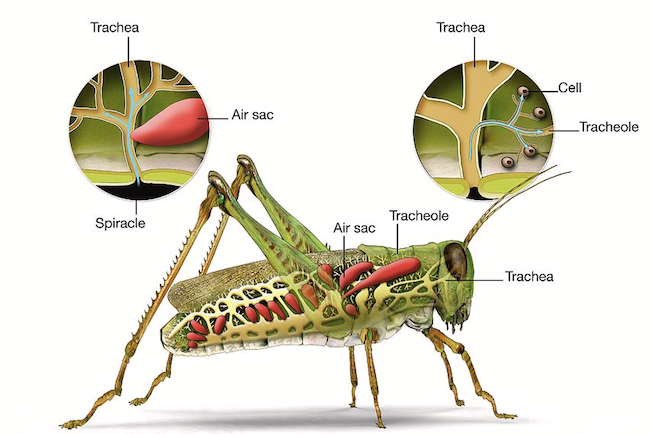
- The lungs are absent in insects therefore the respiration is carried out by a number of hollow tubes (air sacs) found in thoracic and abdominal segments of insect, which is known tracheae and are floating in haemocoel, and the fine branches of tracheae are known as tracheoles.
- Tracheoles form a network over the visceral organs including the alimentary canal as well as the gonads (ovaries, testis) and penetrate into the tissues of the organs and become intracellular and supply oxygen directly to the tissues.
- The spiral thickening of trachea is known as taenidia, it prevents trachea to collapse during respiration but taenidia is absent in tracheoles.
- The air generally enters into trachea through paired lateral outer opening known as spiracles which are situated in the plural side of thoracic and abdominal segments.
- There are a total of 10 pairs of spiracles present in general, 2 pairs in thorax and 8 pairs in abdomen.
- Spiracles are situated on pleural surface. They consist of a small ring like sclerite at opening called ‘peritreme’ leading to a cavity known as ‘atrium’.
- The tracheal system with functional spiracles is called the open tracheal system and with non-functional spiracles is called closed tracheal system.
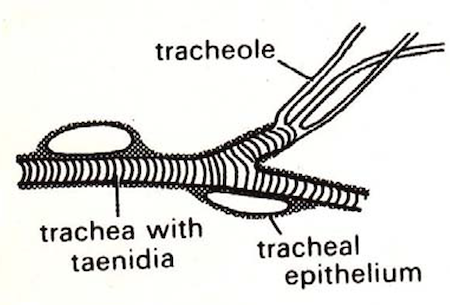
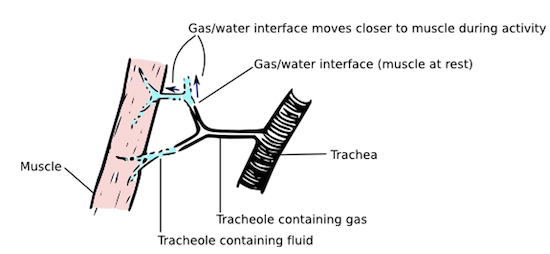
- The trachea coming from spiracles throughout the body join with those of neighbouring spiracles forming ‘longitudinal trunks’.
- There are in total 4 tracheal trunks viz. dorsal trunk, lateral trunks which are two in number and one ventral trunk.
- The dorsal trunk supply oxygen to proximal part of the body as well as to heart whereas the ventral supplies to the central nervous system.
- The two lateral longitudinal trunks spreads tracheoles to alimentary canal, legs, gonads and wings.
Mechanism of respiration
- Oxygen enters the spiracle and passes through the length of the tracheae to the tracheoles and into the target cells by a combination of ventilation and diffusion along a concentration gradient, from high in the external air to low in the tissue.
- Whereas the net movement of oxygen molecules in the tracheal system is inward (Inspiration), the net movement of CO2 and water vapour molecules is outward (Expiration).
Other types of respiration
Cutaneous respiration:**
- E.g.: Protura, Collembola and endoparasitic insects.
- When the spiracles are absent, respiration occurs through body wall which forms main source for gaseous exchange.
Tracheal gills
- E.g.: larva of Trichoptera, nymphs of Ephemeroptera
- Also called as abdominal gills which occur as the outgrowths of the trachea in the form of gills distributed on the lateral sides of the body.
- They are useful for absorption of dissolved oxygen.
- They may vary in shape as lamellate or filamentous.
Spiracular gills
- In some aquatic pupae, Peritreme or atrium of spiracles is drawn out into a long filament-like structure known as spiracular gills.
- These gills are adapted for both aquatic and aerial respiration, enabling the insect to live in air and moist places or completely in water or at the edges of water structures.
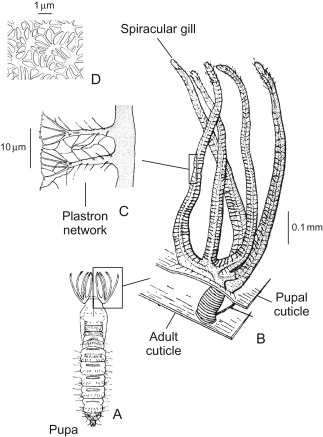
Blood gills
- These are tubular or digitiform or eversible structures present at the anal end of body ranging from 4-6 in larva of Trichoptera.
- In chironomid larva of Diptera, 2 pairs of blood gills are present on penultimate segment and a group of 4 shorter anal gills are present. These are called blood gills as they contain blood but sometimes have trachea.
- Function of these structures is the absorption of water and inorganic ions rather than respiration.
Rectal gills
- In dragonfly nymphs (naids), the rectum modifies into a barrel like chamber where the rectal wall forms into basal thick pads and distal gill filaments which are richly supplied with tracheoles.
- They help in respiration.
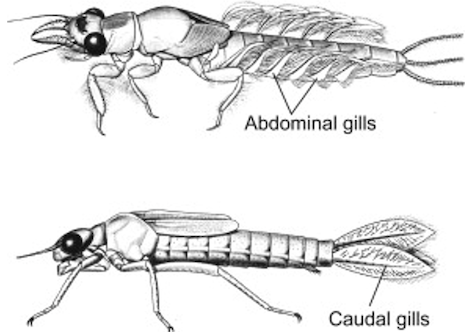
Air sacs
- In many winged insects, the trachea gets dilated at some points to form thin-walled air sacs which do not contain the taenidia.
- These can be seen as glistening sac like structures mainly function as storage structures of air which change their volume with respiratory movement.
Plastron respiration

- E.g.: Aquatic beetles.
- The plastron is a special type of air store in the form of a thin film held by a system of hydrofuge hairs, scales or other cuticular processes whose volume remains constant.
- If there is adequate oxygen dissolved in water, the plastron can act as a permanent physical gill. The trachea opens into plastron.
References
- Insecta - Introduction: K.N. Ragumoorithi, V. Balasurbramani & N. Natarajan
- A General Textbook of Entomology (9th edition, 1960) – A.D. Imms (Revised by Professor O.W. Richards and R.G. Davies). Butler & Tanner Ltd., Frome and London.
- The Insects- Structure and Function (4th Edition, 1998) – R.F. Chapman. Cambridge University Press
- https://www.amentsoc.org/
- Researchgate
- Wikipedia
Which of the following statment is incorrect?
Tracheal System

- The lungs are absent in insects therefore the respiration is carried out by a number of hollow tubes (air sacs) found in thoracic and abdominal segments of insect, which is known tracheae and are floating in haemocoel, and the fine branches of tracheae are known as tracheoles.
- Tracheoles form a network over the visceral organs including the alimentary canal as well as the gonads (ovaries, testis) and penetrate into the tissues of the organs and become intracellular and supply oxygen directly to the tissues.
- The spiral thickening of trachea is known as taenidia, it prevents trachea to collapse during respiration but taenidia is absent in tracheoles.
- The air generally enters into trachea through paired lateral outer …
Become Successful With AgriDots
Learn the essential skills for getting a seat in the Exam with
🦄 You are a pro member!
Only use this page if purchasing a gift or enterprise account
Plan
Rs
- Unlimited access to PRO courses
- Quizzes with hand-picked meme prizes
- Invite to private Discord chat
- Free Sticker emailed
Lifetime
Rs
1,499
once
- All PRO-tier benefits
- Single payment, lifetime access
- 4,200 bonus xp points
- Next Level
T-shirt shipped worldwide

Yo! You just found a 20% discount using 👉 EASTEREGG

High-quality fitted cotton shirt produced by Next Level Apparel